Susie Kearley explores Hartlepool
c776529c-36e6-4afe-a6f5-1e90fc3f289d
We pitch our bijou Freedom caravan at the Crimdon Dene Holiday Park just outside of Hartlepool and have a look around. The facilities seem nice and there's a beach nearby. We go for a stroll along the sand and meet some other caravanners. They're enjoying their stay and say the Historic Dockyard is worth a visit.
So we decide to go there the following day. In the morning, the sun is shining so we jovially head to the Dockyard and can't resist a photo opportunity in the pillory and the stocks – thankfully, without being pelted by any wet sponges or rotten vegetables!
We board HMS Trincomalee – the oldest European warship still afloat. The vessel was originally built in Bombay, India, in 1817. It came to Hartlepool in 1987, and local enthusiasts set about restoring it over the next decade.
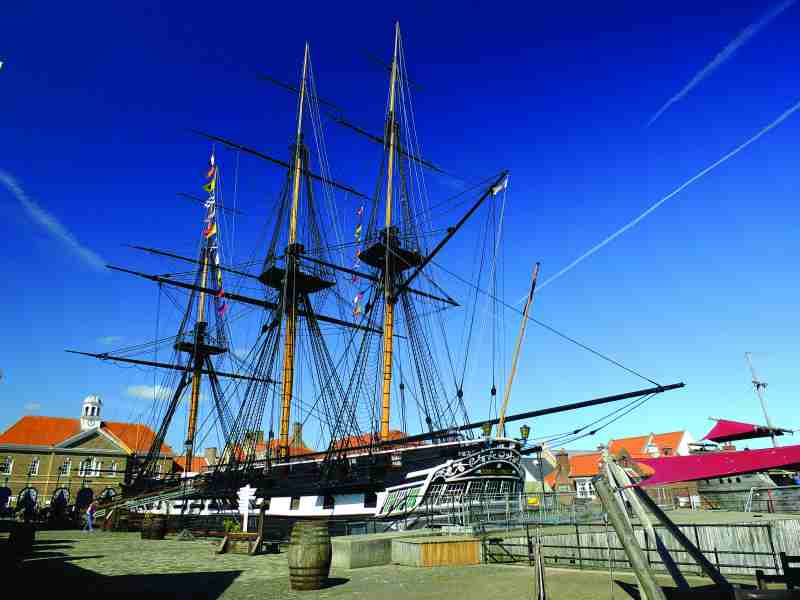
There's an audio guide, providing information about life on board, which brings the whole experience to life. The ship is an imposing structure with cannons lined up along the decks – warships of this age were often heavily fortified. Masts and rigging stand high over our heads, while we take in the awesome structure and learn about HMS Trincomalee's varied naval missions. In her first assignment, she was sent to patrol parts of North America and the West Indies. She became engaged in hurricane relief and in suppressing riots in Haiti. Her presence prevented a Cuban invasion. Then, as part of her second commission, she joined an Anglo-French Squadron, during the Crimean War.
Sailors aboard HMS Trincomalee were faced with a variety of threats to their wellbeing, from the danger of injury in battle, to the threat of disease, malnutrition, or all three! It took tremendous courage for the crew members to live in such difficult conditions.
.jpg)
Captain's table
We see the captain's table, and learn about the challenges of food preparation on board - rats would eat the crew's dinner! The crew are drinking, playing dice, and cards, and we see models of the animals they kept for their milk and meat.
The sailors slept in hammocks – or beds if they were among the elite. The captain's table is laid for a tasty meal of meat, vegetables and gravy. Elsewhere, there are less tasty-looking morsels of food. Mannequins depict a group of workmen doing carpentry on board the ship, while others prepare cannons for battle.
Back on the historic quayside, we explore the 18th century buildings. There's a lot going on. We watch a cannon being fired by a gentleman in traditional dress, and see small quayside businesses supplying the ships with things they need for voyages. Candles, canvasses and cloth are on sale in the shops, and there's a tailor measuring up a captain for his new suit. On this 18th century quayside, you could even buy new swords if you wanted to!
Authentic architectural styles have been adopted in the recreated buildings, and the atmosphere of a period quayside is beautifully captured by actors in costume playing out their roles. We visit the Admiral's House, where the admiral is resting after injuring his foot. The many and varied shops include a chandler, gunsmith, swordsmith, architect, and printer. There's also a jail, and exhibitions in the back of each building, which provide more information about the way of life on an 18th-century dock.
Guides in costume answer questions, and you can catch a display of swashbuckling gallantry that takes place at scheduled times throughout the day, or see the cannon fire if you're there at the right time. We visit the Museum of Hartlepool on the historic quayside. It takes us back 5000 years to the Bronze Age with colourful displays and antiquities telling the story of Hartlepool's past. There are opportunities for kids to get dressed up and interactive exhibits. We see everything from prehistoric axes to children's toys dating from the 1800s; from Anglo-Saxon jewellery to Georgian silver artefacts.
.jpg)
HMS Trincomalee
Nearby is a paddle steamer, constructed in Hartlepool, called PSS Wingfield Castle. It's free to board and explore, and a café operates on-board deck. Our visit to the coastal town of Hartlepool in County Durham is dominated by the Hartlepool Historic Quayside, an 18th century port, recreated with old buildings, wax mannequins, HMS Trincomalee, and seafaring stories.
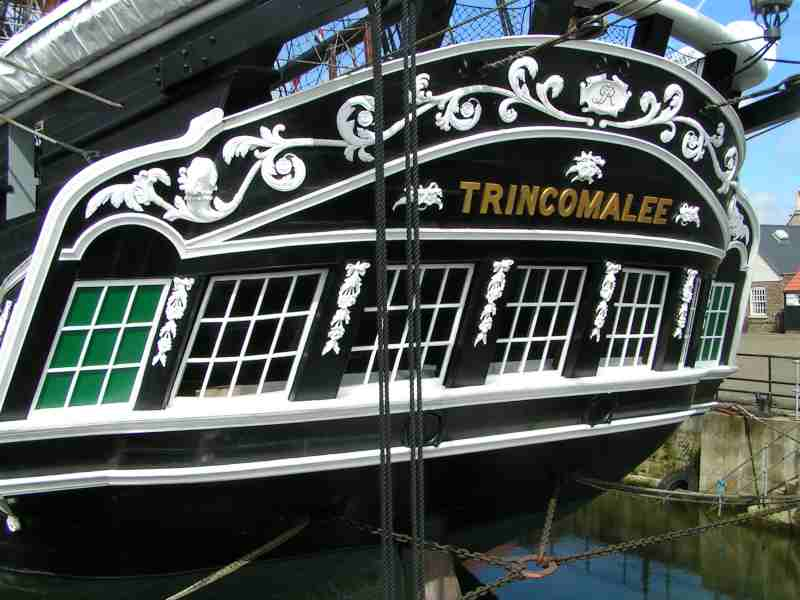
We pitch our bijou Freedom caravan at the Crimdon Dene Holiday Park just outside of Hartlepool and have a look around. The facilities seem nice and there's a beach nearby. We go for a stroll along the sand and meet some other caravanners. They're enjoying their stay and say the Historic Dockyard is worth a visit. So we decide to go there the following day.
In the morning, the sun is shining so we jovially head to the Dockyard and can't resist a photo opportunity in the pillory and the stocks – thankfully, without being pelted by any wet sponges or rotten vegetables!
We board HMS Trincomalee – the oldest European warship still afloat. The vessel was originally built in Bombay, India, in 1817. It came to Hartlepool in 1987, and local enthusiasts set about restoring it over the next decade. There's an audio guide, providing information about life on board, which brings the whole experience to life. The ship is an imposing structure with cannons lined up along the decks – warships of this age were often heavily fortified. Masts and rigging stand high over our heads, while we take in the awesome structure and learn about HMS Trincomalees varied naval missions. In her first assignment, she was sent to patrol parts of North America and the West Indies. She became engaged in hurricane relief and in suppressing riots in Haiti. Her presence prevented a Cuban invasion. Then, as part of her second commission, she joined an Anglo-French Squadron, during the Crimean War.
Sailors aboard HMS Trincomalee were faced with a variety of threats to their wellbeing, from the danger of injury in battle, to the threat of disease, malnutrition, or all three! It took tremendous courage for the crew members to live in such difficult conditions. We see the captain's table, and learn about the challenges of food preparation on board - rats would eat the crew's dinner! The crew are drinking, playing dice, and cards, and we see models of the animals they kept for their milk and meat.
The sailors slept in hammocks – or beds if they were among the elite. The captain's table is laid for a tasty meal of meat, vegetables and gravy. Elsewhere, there are less tasty-looking morsels of food. Mannequins depict a group of workmen doing carpentry on board the ship, while others prepare cannons for battle.
Back on the historic quayside, we explore the 18th century buildings. There's a lot going on.
We watch a cannon being fired by a gentleman in traditional dress, and see small quayside businesses supplying the ships with things they need for voyages. Candles, canvasses and cloth are on sale in the shops, and there's a tailor measuring up a captain for his new suit. On this 18th century quayside, you could even buy new swords if you wanted to!
Authentic architectural styles have been adopted in the recreated buildings, and the atmosphere of a period quayside is beautifully captured by actors in costume playing out their roles. We visit the Admiral's House, where the admiral is resting after injuring his foot. The many and varied shops include a chandler, gunsmith, swordsmith, architect, and printer. There's also a jail, and exhibitions in the back of each building, which provide more information about the way of life on an 18th-century dock.
Guides in costume answer questions, and you can catch a display of swashbuckling gallantry that takes place at scheduled times throughout the day, or see the cannon fire if you're there at the right time.
We visit the Museum of Hartlepool on the historic quayside. It takes us back 5000 years to the Bronze Age with colourful displays and antiquities telling the story of Hartlepool's past. There are opportunities for kids to get dressed up and interactive exhibits. We see everything from prehistoric axes to children's toys dating from the 1800s; from Anglo-Saxon jewellery to Georgian silver artefacts. Nearby is a paddle steamer, constructed in Hartlepool, called PSS Wingfield Castle. It's free to board and explore, and a café operates on-board deck.
Hartlepool Marina
We head along Hartlepool's fashionable £60m Marina, which is considered to be Hartlepool's most alluring and relaxing location. It's surrounded by trendy shops and bars and it's looking pretty under the deep blue sky.
The town has a long sandy beach, which, in warmer weather, would no doubt be lovely, but the day we visit, it's cool and windy, so we stroll along the promenade, and enjoy watching a man with a horse-drawn carriage ride along the sand.
Back at the campsite in the evening, we lose a few coins in the amusement arcade before deciding we're on a losing streak and heading for the bar instead. There are loads of things to do at the holiday park, including children's entertainment and a swimming pool. But we're pooped, so we relax and unwind in a quiet corner of the bar. The following day there's more to explore!
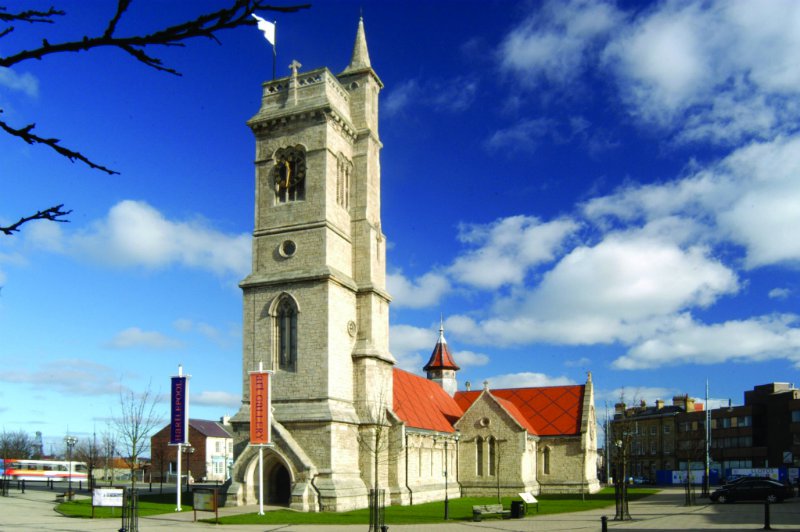
Hartlepool Art Gallery
Hartlepool Art Gallery is worth a visit. It opened inside a disused Victorian church in 1996, and now displays changing exhibitions of local artwork including photography, crafts, and paintings – often linked to historic local themes. One unusual feature of the gallery is the 100ft Clock Viewing Tower. Climb up to see the clock mechanism, and enjoy the sea views. There's also a coffee shop, book and crafts shop inside. Hartlepool Tourist Information Centre and the local theatre box office is located here, too.
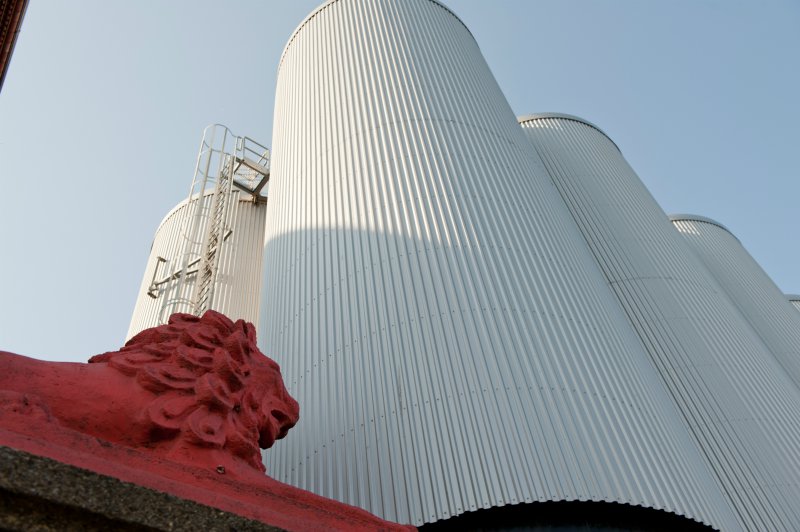
Cameron's Brewery Visitors Centre
The Lion Brewery became established in Hartlepool in 1852, and in 1865 the Cameron family took over running the brewery. Today, visitors can book guided tours of the Cameron's Brewery Visitors Centre to see how the beers are made. Tour guides will answer questions, show you the ropes of beer production, and take you around the marble-lined brewing hall. Then you'll be able to sample some Cameron beers in the bar after your visit. The tour lasts just over an hour and shows you the entrepreneurial flair and innovation that went into the growth of a new brewery, as well as detailing the social history and politics of Hartlepool and the brewing industry over the centuries. There are interactive displays and a sense of fun, but be warned that advance booking is essential. Children under the age of 11 are not permitted on tours.
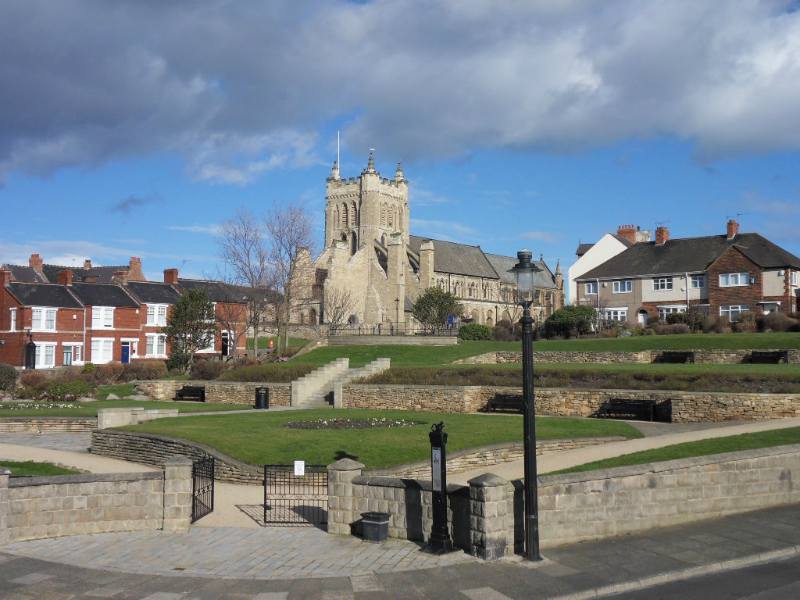
St Hilda's Church
St Hilda's Church dates back to the 13th century. It's located on a holy site, which, in the 7th century, was part of St Hilda's monastic community. Inside are interactive exhibits and short films giving some history of the original Anglo-Saxon Hartlepool monastery, which was founded here in the year 640AD by St Aidan. This original structure was demolished in an attack by the Danish in the 9th century. Visitors can also learn about the de Brus family, who, in the 13th century, built St Hilda's as a burial place for themselves and their descendents.
Where to stay
Crimdon Dene Holiday Park
Coast Road, Blackhall Colliery, Nr Hartlepool
County Durham TS27 4BN
T 0333 2076 652
W parkdeanresorts.co.uk
OPEN 21 March to 31 October
PRICE £30
This campsite is very thorough in providing entertainment and have recently spent £1m on a new clubhouse development. It's a great site for all the family to enjoy.
Ashfield Caravan Park
Dalton Piercy, Hartlepool TS27 3HY
M 07787 568165
W ashfieldcaravanparksite.com
OPEN March to October
PRICE £20
Ashfield Caravan Park is a friendly, family-run campsite, with modern shower blocks, toilets, and private baby changing areas.
Strawberry Hill Farm
Running Waters, Old Cassop, Durham, County Durham DH6 4QA
T 0191 372 3457
W strawberry-hill-farm.co.uk
OPEN 1March to 31 December
PRICE £22
This campsite, 12 miles from Hartlepool, has a modern toilet and shower block, electric hook-up, and a choice of grass or hardstanding pitches.
Coast Road, Blackhall Colliery, Nr Hartlepool
County Durham TS27 4BN
T 0333 2076 652
W parkdeanresorts.co.uk
OPEN 21 March to 31 October
PRICE £30
This campsite is very thorough in providing entertainment and have recently spent £1m on a new clubhouse development. It's a great site for all the family to enjoy.
Ashfield Caravan Park
Dalton Piercy, Hartlepool TS27 3HY
M 07787 568165
W ashfieldcaravanparksite.com
OPEN March to October
PRICE £20
Ashfield Caravan Park is a friendly, family-run campsite, with modern shower blocks, toilets, and private baby changing areas.
Strawberry Hill Farm
Running Waters, Old Cassop, Durham, County Durham DH6 4QA
T 0191 372 3457
W strawberry-hill-farm.co.uk
OPEN 1March to 31 December
PRICE £22
This campsite, 12 miles from Hartlepool, has a modern toilet and shower block, electric hook-up, and a choice of grass or hardstanding pitches.








Recent Updates
Caravan showers: all you need to know
In this guide, we’ll discuss the different types of showers, how they work, and how to fit an external shower point to your caravan ...
Caravan towing: all you need to know
Towing a caravan may seem daunting initially, but a few simple tips can make the journey enjoyable and ...
All you need to know about towbars & towballs
Flange, detachable, swan neck, retractable – towbar technology choice is bewildering. Don’t worry. We’ll ...
Caravan WiFi: everything you need to know
Caravan holidays are the ultimate way of getting away from it all, although we sometimes need a link to the ...
Caravan insurance: all you need to know
Navigating the world of caravan insurance can feel like a daunting task. Fear not, as this comprehensive ...
Buying a caravan: what you need to know
Let us guide you through some of the complicated things to think about when first looking at buying a ...
Caravan awnings: a buyers' guide
Caravan awnings are a fantastic addition to any caravan as they are one of the simplest, quickest and most ...
Caravan electrics: avoid tripping out
All caravan owners have overloaded their mains supply at some time. Here’s how to master caravan electrics ...
Caravan heating systems: a quick guide to caravanning warmth
When winter is here, you’ll be glad of a decent caravan heating system if you’re out touring. Here’s how the ...
Caravan damp: a complete guide
There's little more guaranteed to strike fear into the heart of a caravan owner than the word 'damp'. But if ...
Other Articles
Caravan jockey wheels: the definitive guide
A well-functioning caravan jockey wheel can make all the difference to manoeuvring away from the towcar, especially if you don't have a caravan mover ...
Caravan cooking recipes
Caravan cookery inspirational ideas. No need to stress out in the kitchen with these quick and easy ...
Caravan bike racks: a complete guide
Exploring the beautiful surroundings while on a caravan trip is undeniably one of the greatest joys of the ...
A guide to solar power in your caravan
Not that many years ago, mains electrical hook-up on campsites was considered a bit of a luxury, and, for ...
The ultimate guide to caravan layouts
Choosing the right layout or floorplan of your caravan is an all-important part of the buying process – find ...
A guide to seasonal caravan pitches
Our in-depth guide to finding and securing seasonal caravan pitches on your favourite campsite ...
Caravan weights and payloads: a quick guide
The terminology of caravan weight – MIRO, MTPLM, noseweight, kerbweight, payload, weight plate upgrade – is ...
The ultimate guide to caravan motor movers
Caravan motor movers: everything you need to know about remote control caravan manoeuvring ...
Caravan cleaning: All you need to know
Whether you’re taking the caravan out for the first time or it’s just in need of a spruce up, our guide will ...
18 essential items for camping with your dog
Camping is for the whole family – including our four-legged members. Here's what you'll need to keep your dog ...